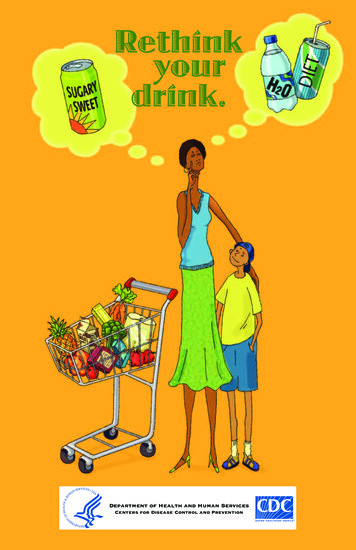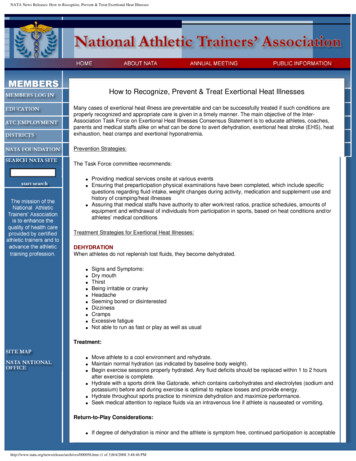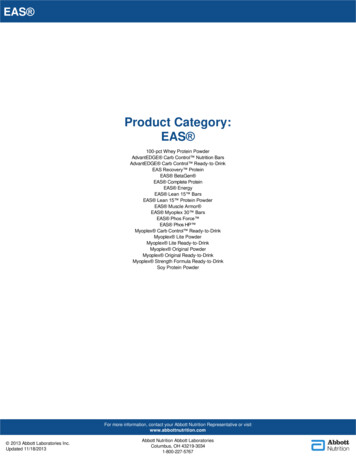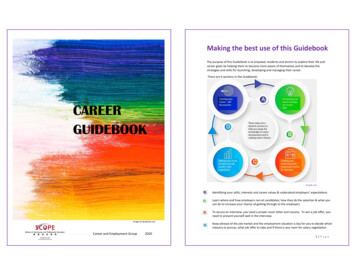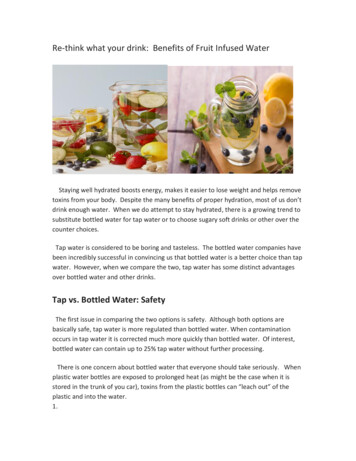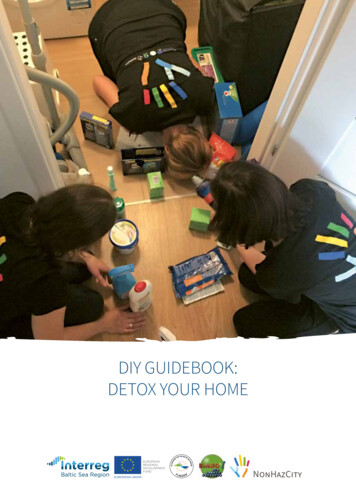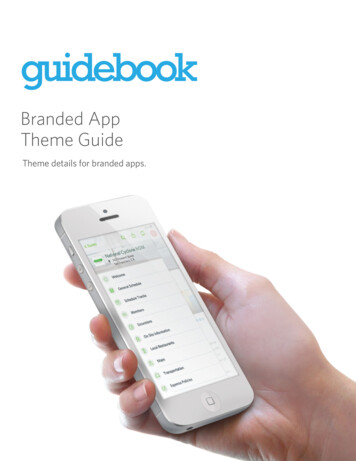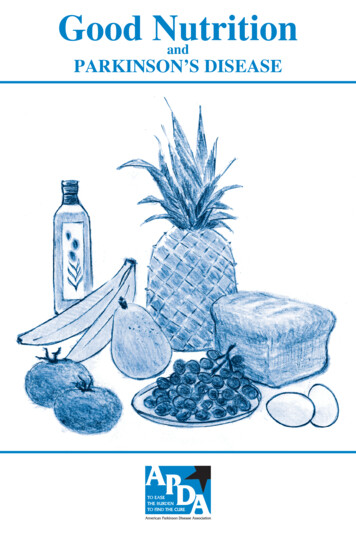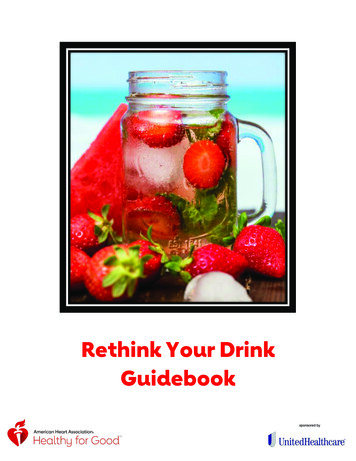
Transcription
Rethink Your DrinkGuidebooksponsored by
Rethink Your Drink GuidebookWhat you will find in this guide:Educational Messages Sugary Beverages by the Numbers Social Media MessagesEvents Lunch & Learn Talkso Talk #1 – Too Much Sugar Isn’t So Sweet for your Healtho Talk #2 – Sneaky Sugaro Talk #3 – Healthy Kids are Sweet Enougho Talk #4 – Artificial Sweeteners in the Real World Rethink Your Drink Educational Activities/Event Ideas Guideo Hidden Sugars Demonstrationo Bring Your Water Bottle to Work Day/ 30-Day Water ChallengeResources Sip Smarter Added Sugar is Not So Sweet Cut Out Added Sugars Rethink Your Drink Flyer for employee break room Infused Water Recipessponsored by
Rethink Your Drink Educational Messages:Sugary beverages by the numbersMost Americans consume nearly 20 teaspoons of added sugars each day.That’s more than triple the recommended daily limit for women anddouble for men!Sugar-sweetened beverages like soda and energy/sports drinks are the #1source of added sugars in our dietA 12 oz can of regular soda has about 150 calories and 10 teaspoons ofadded sugarThe American Heart Association recommended daily limit for added sugarsis 6 teaspoons for women & kidsThe American Heart Association recommended daily limit for addedsugars is 9 teaspoons for menThe average American consumes 39 pounds of sugar per year from sodaand other sweetened drinkssponsored by
Rethink Your Drink Social Media Messages:Campaign hashtags: #pdxgoesred #rethinkyourdrinkORSample Tweets: Sugary drinks are the #1 source of calories in teens’ diets – even over pizza!#DidYouKnow: Consumption of sugar-loaded drinks has increased 500% in thepast fifty years? #pdxgoesred #rethinkyourdrinkORDRINK beverages with 0-5g of sugar per 12oz. DON’T DRINK beverages with over12g of sugar per 12oz. #pdxgoesred #rethinkyourdrinkORSip Smarter. Replace sweetened drinks to cut back on added sugars and emptycalories. Sip Smarter #pdxgoesred #rethinkyourdrinkORYou’d have to walk from the MODA Center to the Portland Aerial Tram inPortland to burn off just one 20 ounce soda #pdxgoesred #rethinkyourdrinkORDid you know that one 20-oz bottle of soda has the same amount of sugar as 6donuts? #pdxgoesred #rethinkyourdrinkORToday at [insert company name] we’re swapping sugar-sweetened beveragesfor water. Join the movement. #pdxgoesred #rethinkyourdrinkOREmployees at [insert company name] are taking the 30-day challenge to drink 88-oz servings of water per day – join us! #pdxgoesred #rethinkyourdrinkORSample Facebook or Instagram Posts: Every sip counts! People who consume sugary drinks regularly – 1 to 2 cans aday or more – have a 26% greater risk of developing type 2 diabetes than peoplewho rarely have such drinks. #pdxgoesred #rethinkyourdrinkORWe’re thirsty for change! Say YES to more water and NO to sugar-sweeteneddrinks. Share this if you agree! #pdxgoesred #rethinkyourdrinkORYou’d have to walk from the Oregon Zoo to Pioneer Courthouse Square to burnoff just one 20 ounce soda. #pdxgoesred #rethinkyourdrinkOR (or find similar3.3. mile distance in your community)Ideas to help with making healthy beverage choices: Choose and stock fridgewith water, diet, or low-calorie beverages instead of sugary ones. Carry a waterbottle. Snazz up your water with fruit slices. Serve water with meals.#pdxgoesred #rethinkyourdrinkORToday at [insert company name] we’re swapping sugar-sweetened beveragesfor water. Join the movement. #pdxgoesred #rethinkyourdrinkOR (Includephoto of employees with water bottles.)Employees at [insert company name] are taking the 30-day challenge to drink 88-oz servings of water per day – join us! #pdxgoesred #rethinkyourdrinkOR(Include photo of employees with water bottles or 30-day water challengepledge cards.)sponsored by
Rethink Your Drink Lunch & Learn TalksHost a weekly Rethink Your Drink Lunch & Learn for employees during the month ofJuly, with a focus on the 4 topics outlined below. Alternatively, these talking points canbe folded into an existing weekly staff meeting.Topic #1: Too Much Sugar Isn’t So Sweet for your HealthMany people consume more sugar than they realize. It’s important to be aware of how much sugar youconsume because our bodies don’t need sugar to function properly. Added sugars contribute zeronutrients but many added calories that can lead to extra pounds or even obesity, thereby reducing hearthealth.There are two types of sugars in American diets: naturally occurring sugars and added sugars.1. Naturally occurring sugars are found naturally in foods such as fruit (fructose) and milk (lactose).2. Added sugars include any sugars or caloric sweeteners that are added to foods or beverages duringprocessing or preparation (such as putting sugar in your coffee or adding sugar to your cereal).Added sugars (or added sweeteners) can include natural sugars such as white sugar, brown sugarand honey as well as other caloric sweeteners that are chemically manufactured (such as highfructose corn syrup).How Much is Just Right?The American Heart Association (AHA) recommends limiting the amount of added sugars you consumeto no more than half of your daily discretionary calories allowance. For most American women, that’s nomore than 100 calories per day, or about 6 teaspoons of sugar. For men, it’s 150 calories per day, orabout 9 teaspoons. There are four calories in one gram of sugar, so if a product has 15 grams of sugarper serving, that’s 60 calories just from the sugar alone.For reference, a typical 12-ounce can of regular soda has 130 calories and 8 teaspoons of sugar.Think of your daily energy need as a budget. You’d organize a real budget with “essentials” (things likerent and utilities) and “extras” (such as vacation and entertainment). In a daily calorie budget, theessentials are the minimum number of calories you need to meet your nutrient needs.How to Find Sugar:Read food labels. Syrup, molasses, cane juice and fruit juice concentrate mean added sugar, as well asmost ingredients ending with the letters “ose” (like fructose and dextrose).How to Replace Sugar: Enjoy fruit for dessert most days and limit traditional desserts to special occasions. Cut back on the amount of sugar you add to things you eat or drink often. Buy 100% juice with no added sugars. Enhance foods with spices – try cinnamon, nutmeg or ginger. Add fresh or dried fruit to cereal and oatmeal. Drink sparkling water, unsweetened tea or sugar-free beverages.sponsored by
Topic #2: Sneaky SugarFinding Added Sugars in FoodUnfortunately, you can’t tell easily by looking at the nutrition facts panel of a food if it contains addedsugars. The line for “sugars” includes both added and natural sugars.Naturally occurring sugars are found in milk (lactose) and fruit (fructose). Any product that contains milk(such as yogurt, milk or cream) or fruit (fresh, dried) contains some natural sugars.Reading the ingredient list on a processed food’s label can tell you if the product contains added sugars,just not the exact amount if the product also contains natural sugars.Names for added sugars on labels include:Brown sugarCorn sweetenerCorn syrupFruit juice concentratesHigh-fructose corn syrupHoneyInvert sugarMalt sugarMolassesRaw sugarSugarSyrupSugar molecules ending in “ose” (dextrose, fructose, glucose, lactose, maltose, sucrose)Furthermore, some labels include terms related to sugars. Here are some common terms andtheir meanings:Sugar-Free – less than 0.5 g of sugar per servingReduced Sugar or Less Sugar – at least 25 percent less sugars per serving compared to a standardserving size of the traditional varietyNo Added Sugars or Without Added Sugars – no sugars or sugar-containing ingredient such asjuice or dry fruit is added during processingLow Sugar – not defined or allowed as a claim on food labelsKeep in mind that if the product has no fruit or milk products in the ingredients, all of the sugars in thefood are from added sugars. If the product contains fruit or milk products, the total sugar per servinglisted on the label will include added and naturally occurring sugars.Although sugars are not harmful in small amounts to the body, our bodies don’t need sugars to functionproperly. Added sugars contribute additional calories and zero nutrients to food.Over the past 30 years, Americans have steadily consumed more and more added sugars in their diets,which has contributed to the obesity epidemic. Reducing the amount of added sugars we eat cutscalories and can help you improve your heart health and control your weight.sponsored by
Topic #3: Healthy Kids are Sweet EnoughHow to keep your kids and teens sugar healthyKids age 2–18 should have less than 25 grams or 6 teaspoons of added sugar daily for a healthy heart.The typical American child eats about triple the recommended amount of added sugars, half from foodand half from drinks.It takes the whole family to stay healthy, share these easy swaps/tips with your family to keep everyonewithin healthy sugar limits!Baking and Cooking: Unsweetened applesauce can substitute for some of the sugar in a recipe.You may need less oil, too – adjust the recipe as needed to get the taste and texture you like. Or tryusing a no-calorie sweetener suitable for cooking and baking.Desserts and Sweets: Instead of indulging in a traditional sugar-based dessert, enjoy the naturalsweetness of fruit. Fresh, frozen and canned (in its own juice or water) are all good choices. Try thembaked, grilled, stewed or poached.Dressings and Sauces: Swap store-bought bottled salad dressings, ketchup, tomato sauce andbarbeque sauce – which can have a lot of added sugars – for homemade versions so you can controlthe amount of sugar added to them.Snack Mix and Granola: Make your own, without all the added sugars. Combine your favoritenuts and seeds (unsalted or very lightly salted), raisins and dried fruits (unsweetened), rolled oats andwhole-grain cereal (non-sugared/non-frosted) – and skip the candy!Soda/Soft Drinks: Swap sugar-sweetened beverages for plain or sparkling water flavored withmint, citrus, cucumber or a splash of 100% fruit juice.Tea and Coffee: Cut back on sugars (including honey and agave syrup) gradually until your tasteadjusts to less sweetness. Try adding natural flavors like cinnamon, citrus, mint or nutmeg.sponsored by
Topic #4: Artificial Sweeteners in the Real WorldGot a sweet tooth? Here’s the scoop on artificial sweeteners or “Non-NutritiveSweeteners” as we call themThe AHA strongly recommends limiting added sugars. Too much sugar can lead to weight gain, andthose extra pounds can lead to a string of health problems. In addition to obesity, it can increasetriglyceride levels, a risk factor for heart disease.Not only are foods and drinks that are high in added sugars generally high in calories and low innutritional value, they also take the place of more nutritious foods. For example, reaching for a regularsoda instead of low-fat or non-fat milk.The American Heart Association labels low-calorie sweeteners, artificial sweeteners, and noncaloricsweeteners as non-nutritive sweeteners (NNSs), since they offer no nutritional benefits such as vitaminsand minerals. They may be low in calories or have no calories, depending upon the brand.The FDA has given the label “Generally Recognized as Safe”, to five* NNSs:1. Aspartame (NutraSweet and Equal )2. Acesulfame-K (Sweet One )3. Neotame4. Saccharin (Sweet’N Low )5. Sucralose (Splenda )*Stevia (Truvia and PureVia ) doesn’t have a GRAS distinction, but that doesn’t mean it’sdangerous (it just means there isn’t enough evidence yet either way).Replacing sugary foods and drinks with sugar-free options containing NNSs is one way to limit caloriesand achieve or maintain a healthy weight. Also, when used to replace food and drinks with addedsugars, it can help people with diabetes manage blood glucose levels. For example, swapping a fullcalorie soda with diet soda is one way of not increasing blood glucose levels while satisfying a sweettooth.As you make healthy choices throughout your day, choose foods and beverages that are high innutrients and low in saturated and trans fats and added sugars. Keep in mind that just because aproduct is “sugar free,” it doesn’t always mean that it’s healthy.Foods and beverages that contain NNSs can be included in a healthy diet, as long as the calories theysave you are not added back by using foods as a reward later in the day, adding calories that take youover your daily limit.sponsored by
Rethink Your Drink Educational Activities/Event Ideas Guide:Hidden Sugars Demonstration – All you need is a bag of sugar and a measuring cup toraise awareness of how much sugar we consume by drinking even just one sugarybeverage per day!Demonstration Ingredients:Supplies: 1 bag of sugar1 bag of sugar cubes1 empty 2-liter soda bottle1 empty 20-oz. soda bottleMeasuring cupHandouts: Sip SmarterCut Out Added SugarsActivity & Talking Points:Part 1: Define sugar-sweetened beverages and lead discussion and demonstration onsugar consumption.What is a sugar-sweetened beverage?Any beverage with added caloric sweetener including soda, other carbonated softdrinks, juice drinks, sports drinks, energy drinks, sweetened milk or milk alternatives andsweetened tea or coffee drinks.Caloric sweeteners include: high fructose corn syrup, cane sugar, fructose, fruit juiceconcentrate, glucose, sucrose, honey, brown sugar, dextrose and corn sweetener.[Ask the Audience] How much added sweeteners including sugar do you think theaverage American eats in a year?[Answer]Almost 100 pounds a year which is almost a quarter pound ofsugar and other calorie-rich sweeteners a day![Display]¼ lb of sugar in a 2 liter soda bottleIt’s no wonder that two out of three Americans are overweight or obese – the averageperson eats almost a quarter-pound of added sugar and other calorie-rich sweetenersa day! A quarter pound is equal to 28 teaspoons (or about 28 cubes) of sugar. Here, letme show you.sponsored by
[Display]This is what a quarter pound of sugar looks like (Hold up 28 sugarcubes in a baggie.)Extra calories from all this sugar and other calorie-rich sweeteners can lead to weightgain, obesity, and can contribute to serious health problems such as heart disease,type 2 diabetes, and certain cancers.Part 2: Hidden Sugars Demonstration – As you lead this part of the discussion, have apartner scoop and count teaspoons of sugar into your empty soda bottle to give avisual demonstration of high sugar content.[Ask the Audience] How many teaspoons of sugar are in a 20-oz. soda bottle?[Answer]17 teaspoonsLet’s see what 17 teaspoons of sugar looks like. [Ask for a volunteer to count out 17sugar cubes from the baggie and put them in the 20-oz. soda bottle.]Ok. Take a look at this bottle. This is the amount of sugar in just one soda drink. TheAmerican Heart Association recommends no more than six teaspoons of sugar per dayfor adult women and no more than nine teaspoons for adult men.[Ask the Audience] How long do you think you would have to walk briskly to burn offthe 240 excess calories from one 20-oz. soda?[Answer]3.3 miles – that’s the distance between the MODA Center and thePortland Aerial Tram here in PortlandWrap-Up: What you can do. Pick healthy beverage choices. Choose water, diet or low-calorie beveragesinstead of sugar-sweetened beverages. Add slices of lemon, lime, cucumber oryour favorite fruit to make it more fun!Bring a water bottle to school to drink out of throughout the day.sponsored by
Bring Your Water Bottle to Work Day / 30-Day Water Challenge: On average,employees spend almost half of their waking hours working, so work environments thatpromote employee well-being go a long way toward fostering good health! Use thesefun and easy event ideas to encourage increased water consumption among youremployees. At minimum, you need only promote the event using the email templatesprovided here. If you want to increase excitement, plan a kick-off event and offerincentives (such as cafeteria coupon for healthy items or company-branded waterbottles.) You can also use the handouts to provide further information on healthybeverage choices.Demonstration Supplies:Promotional email templatesHandouts:3-Day Water Challenge Tracking SheetRethink Your Drink Recipe CardsRethink Your Drink 30-Day Water Challenge Email TemplatesEvent Announcement EmailSubject: A message from the [President, CEO – fill in as appropriate]Did you know? Sugar-sweetened beverages are the #1 source of added sugar in theAmerican diet. We didn’t either and now that we do we want to raise awareness byparticipating in Rethink Your Drink for the month of July.Reducing consumption of these drinks can improve health outcomes. Moving towardgood health is about taking small steps each day to improve what we’re drinking,eating and doing. We will take a small, but significant, step together by kicking offRethink Your Drink Month on Monday, July 1st with an initiative to get everyone in thecompany drinking more water.Why drink more water? Water is calorie-free, hydrating and something on which everysystem of the body depends.Stay tuned as we provide tips, recipes and information on how [COMPANY NAME] willcelebrate Rethink Your Drink Month.sponsored by
Event Reminder Email with DetailsSubject: A message from the [President, CEO – fill in as appropriate]On [insert date], we will be celebrating Rethink Your Drink Month. We will join theAmerican Heart Association, UnitedHealthcare and companies across Oregon & SWWashington as they pledge to make healthier beverage choices.Here’s what you can do to join in the celebration: [Insert Date] is our official kickoff with Bring Your Water Bottle to Work Day Bring other healthy beverages to work including water, seltzer water and skim or 1%milk Join our 30-day Water Challenge and pledge to make healthier beverage choices(see attached Tracker Tool) Make healthier choices at the vending machine: Choose water instead of sodas,sports drinks, sweetened coffee drinks and other sugar-sweetened beverageI look forward to drinking our way to health together!sponsored by
Rethink Your Drink Month: 30-Day Water ChallengePledge: I, [Name], pledge to join my fellow team members to move towardhealthier beverage choices by drinking more water and fewer sugar-sweetenedbeverages!Goal” Drink eight 8-ounce servings of beverages with no added sugars orartificial sweeteners every day for the next thirty days.Use the chart below to keep track of your progress toward your goal30 dayChallenge –GO!Day 1Day 2Day 3Day 4Day 5Day 6Day 7Day 8Day 9Day 10Day 11Day 12Day 13Day 14Day 1512345678Halfway there! Great job!Day 16Day 17Day 18Day 19Day 20Day 21Day 22Day 23Day 24Day 25Day 26Day 27Day 28Day 29Day 30Day 31sponsored by
Replace sweetened drinks to cut back on added sugarsand empty calories.REPLACE SUGARY BEVERAGES WITH BETTER CHOICES! full-calorie soft drinks energy/sports drinks sweetened “enhanced water” drinks sweet tea sweetened coffee drinks The best thing you can drink is water! Try it plain,sparkling or naturally flavored with fruit or herbs. Drink coffee and tea without added sugars for ahealthier energy boost. For adults, diet drinks may help replace high-caloriesodas and other sugary drinks.THE FACTS MAY SURPRISE YOU.Most Americans consume nearly20 TEASPOONSEACH DAY.That’s more than TRIPLE theSugar-sweetened beverageslike soda and energy/sportsdrinks are theof added sugarsSOURCE OFADDED SUGARSIN OUR DIET.recommended daily limit for womenandDOUBLE for men!A can (12 FL OZ) ofregular soda has about150 CALORIES AND10 TEASPOONSof added sugar.TRY THESE TIPS TO QUENCH YOUR THIRSTWITH LESS ADDED SUGARSSTART CUTTING BACK.CHOOSE WATER.Take steps to reduce or replace sugarydrinks in your diet:Make water the easy, moreappealing go-to choice:REPLACE most of your drinks CARRY a r efillable water bottle.with water.REDUCE the amount of sugar inyour coffee or tea gradually untilyour taste adjusts to less sweetness.ADD a splash of 100% fruit juiceor slices of citrus, berries andeven cucumbers for a boost of flavor.TRY seltzer, club soda or sparklingADD plain or sparkling water todrinks to keep some of the flavorwith less added sugars per servings.water if you crave the fizz.MAKE IT AT HOME.Family favorites like hot chocolate,lemonade, smoothies, fruit punch,chocolate milk and coffee drinkseasily can be made at home withless added sugars.S TART WITH UNSWEETENEDbeverages, then flavor to taste withadditions like fruit, low-fat or fat-freemilk, and herbs and spices.Get great recipes for beverages and moreat HEART.ORG/RECIPES.READ THE LABEL, AND CHOOSE WISELY.Some drinks that appear to be healthy may be high incalories and added sugars. Check servings per containerand ingredients list.Added sugars go by many names, including sucrose, glucose,maltose, dextrose, high fructose corn syrup, cane syrup,concentrated fruit juice, agave nectar and honey.EAT SMARTsponsored byADD COLORMOVE MOREBE WELLFOR MORE TIPS ON HEALTHY EATING, COOKING AND RECIPES: 2018, American Heart Association 7/18DS13619HEART.ORG/EATSMART
AISDDEDSOTONSome sugars are naturally in fruits,vegetables, milk & grains.Other sugars — the kind added to foods,drinks and condiments during processing— may increase heart disease risk.THEAMERICAN HEART ASSOCIATIONRECOMMENDSlimiting added sugars to no more than 100 calories aday (6 teaspoons) for most women & no more than150 calories a day (9 teaspoons) for most men.FIND ITRead food labels. Syrup, molasses, canejuice and fruit juice concentrate meanadded sugar as wellas most ingredientsending with theletters “ose” (likefructose & dextrose).Enjoy fruit for dessert most daysand limit traditional desserts tospecial occasions.Cut back on the amount of sugaryou add to things you eat ordrink often.Buy 100% juice withno added sugars.A typical 12-ounce can ofregular soda has 130 caloriesand 8 teaspoons of sugar.Added sugar also sneaksinto seemingly “better foryou” beverages, such assports drinks, fruit drinksand flavored milks.ADDED SUGAR SOURCESSugar-sweetened beverages are the biggest source of addedsugar in the American diet. Other sources are baked items (likecakes, muffins, cookies and pies), ice cream and candy.REPLACE ITEnhance foods with spices —try cinnamon, nutmeg or ginger.Drink sparkling water,unsweetened tea or sugar-freebeverages.Add fresh or dried fruit to cerealand oatmeal.Eating and drinking a lot of added sugar is one probable cause of the obesity epidemic in the U.S. It’s also linked toincreased risks for high blood pressure, high cholesterol, diabetes and inflammation in the body.sponsored byFor more tips on healthy eating, cooking and recipes:heart.org/simplecooking 2014 American Heart Association. 4/3DS7892
MAmerican Heart Association.Health for GoodEAT SMART ADD COLOR MOVE MOREBE WELLCUTOUTADDED SUGARSAdded sugars are sugars added to foods and beverages when they're processedor prepared. Consuming too much can hurt your health and even shorten your life.The American Heart Association recommendeddaily limit for added sugars:WOMEN& KIDS*MEN625100936150M i;i!UWM Where to watch for added sugars:SUGARYDRINKSSWEETENEDBREAKFASTSFlavored Milk& Energy DrinksSoda & Soft DrinksCoffee & TeaJuice & Fruit DrinksSportsBreakfast& Energy Bars& MuesliGranolaHot& Cold CerealsSYRUPS ANDSWEETSSyrups& MolassesJelly, Jam & SpreadsHoneyYogurtsDrink MixesSmoothiesCandyFROZENTREATSIce Cream& GelatoFrozen YogurtPopsiclesSherbet& SorbetSWEETBAKED GOODSSweet Rolls& Breads& PiesCakes, CookiesDonuts& PastriesSnack FoodsFrozen DessertsDessertsHow to avoid them:Always check nutrition facts label & ingredients.Replace candy & desserts with naturally sweet fruit.Limit sugary drinks & foods.Make items at home with less added sugars.LEARN MORE ATHEART.ORG/HEALTHYFORGOOD*ages 2 (children under 2 should not consume llllll added sugars)
Rethink Your DrinkSubstituting just one sugar sweetenedbeverage each day with water can helpcut over 1,000 calories in one week!Try fruit or herb infused water for adelicious alternative!sponsored by
sponsored by
sponsored by
Honey Invert sugar Malt sugar Molasses Raw sugar Sugar Syrup Sugar molecules ending in "ose" (dextrose, fructose, glucose, lactose, maltose, sucrose) Furthermore, some labels include terms related to sugars. Here are some common terms and their meanings: Sugar-Free - less than 0.5 g of sugar per serving . Reduced Sugar or Less Sugar
